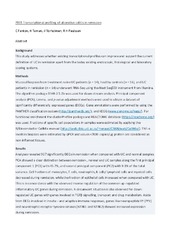Transcriptional profiling of ulcerative colitis in remission
Permanent link
https://hdl.handle.net/10037/16650View/
Date
2019-01-25Type
Journal articleTidsskriftartikkel
Abstract
Background - This study addresses whether existing transcriptional profiles can improve and support the current definition of UC in remission apart from the today existing endoscopic, histological and laboratory scoring systems.
Methods - Mucosal biopsies from treatment-naïve UC patients (n = 14), healthy controls (n = 16), and UC patients in remission (n = 14) underwent RNA-Seq using the Next Seq550 instrument from Illumina. The algorithm package STAR-2.5.2b was used for down-stream analysis. Principal component analysis (PCA), Limma, and p-value adjustment methods were used to obtain a dataset of significantly differentially expressed genes (DEGs). Gene annotations were performed by using the PANTHER classification system (http://pantherdb.org/), and KEGG (www.genome.jp/kegg/). For functional enrichment the clusterProfiler package and REACTOME database (https://reactome.org/) was used. Fractions of specific cell populations in samples were estimated by applying the R/Bioconductor CellMix manual (http://web.cbio.uct.ac.za/~renaud/CRAN/web/CellMix/). TNF-α levels in biopsies were estimated by qPCR and values <7000 copies/µg protein are considered as non-inflamed tissues.
Results - Analyses revealed 927 significantly DEGs in remission when compared with UC and normal samples. PCA showed a clear distinction between remission-, normal and UC samples along the first principal component 1 (PC1) with 45.7%, and second principal component (PC2) with 9.3% of the total variance. Cell fractions of monocytes, T cells, neutrophils, B cells/ lymphoid cells and myeloid cells decreased during remission, while the fraction of epithelial cells increased when compared with UC. This is in concordance with the observed inverse regulation of the common up-regulated inflammatory UC genes during remission. A circumvent situation is also observed for down-regulated UC genes with genes involved in TGFβ signalling, transport and drug metabolism. Aside from DEGs involved in innate—and adaptive immune responses, genes like neuropeptide YY (PYY) and neurotrophic receptor tyrosine kinases (NTRK1 and NTRK2) showed increased expression during remission.
Conclusions - Apart from reduced major key inflammatory activities seen for UC, we propose that a gut–brain communication network is involved during remission beside the partial restoration of immunological functions and recovery of local homeostasis in the epithelial mucus layer and lamina propria. In addition, a certain role for the composition of bacterial gut flora may be implied. These results can be useful for the development of treatment strategies for remission and might be useful molecular targets for further investigations aiming to predict relapse of UC patients in the future.


 English
English norsk
norsk